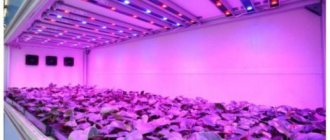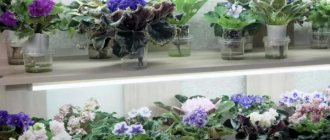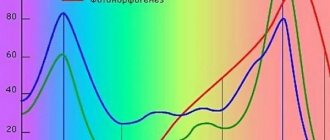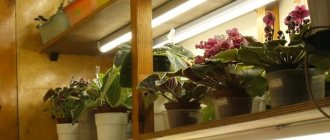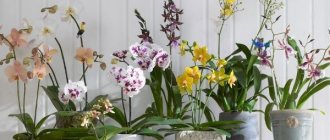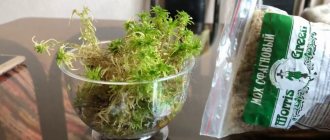Author of the article
Daria Vorontsova
Reading time: 29 minutes
AA
I collected bit by bit information about phytolamps from various sources to write this article: how to choose a phytolamp for seedlings, how to use lighting devices correctly so that the seedlings are strong and healthy. After reading the article, you will have a piece of my personal experience and mistakes, as well as complete information about the types of phytolamps and their use. The rating, based on reviews from experienced gardeners, will help you decide on the most suitable device.
Why do you need additional lighting for seedlings?
In order for a plant to develop harmoniously, it needs natural light.
Lack of ultraviolet radiation leads to reduced seedling growth and withering of shoots. The sprouts that have barely hatched are thin and look weak and lifeless. The greatest deficit of sunlight occurs in January – March. It is at this time that the sowing of seeds for seedlings begins.
Exotic plants also need additional lighting. The length of daylight hours for them should be at least 12 hours. You can increase the amount of useful radiation using special devices - phytolamps.
Little tricks for lighting plants
Ordinary mirrors will help to slightly increase the intensity of the most useful natural light. They are installed on the side slopes of window openings. As a result, the light reflected in the side mirrors and plants is much lighter. When only slanting rays of the sun enter the window for a short time, such a little trick helps to extend the daylight hours. And, besides, a little sun in the room in winter will not be superfluous. And such a window looks quite beautiful, and the flowers are reflected in the mirrors and there are “more of them.”
To make illumination of potted plants more effective, reflectors (reflectors) and reflective surfaces are used. They are positioned so that they reflect artificial light towards the plants. As a reflector, you can use foil, white glossy fabric or special reflectors for lamps. Traditional tulle curtains on the windows also partially reflect light, including daylight. If they separate the plants on the windowsill from the room, then the reflected and diffused light from the curtain hits the plants. If the tulle is located in the path of sunlight to the plant, then the light intensity decreases.
The length of daylight hours and the correct alternation of day and night are extremely important for all types of plants. It is not at all useful to shine light irregularly, from time to time, disrupting the biorhythms to which all living things obey. To maintain the optimal regime, a timer is indispensable! Having a timer is also important in order to safely leave powerful lamps on at home when leaving early in the morning for work. They will turn off after half an hour, even if you forget to do so before leaving.
It is useful to regularly monitor the condition of windows and reflective surfaces and clean them of dust and dirt. The window appears clean and transparent, but a thin layer of dust greatly reduces the intensity of daylight.
What is a phytolamp
The device allows you to obtain a wide spectrum of electromagnetic radiation necessary for the growth and development of the plant. Powered by LED or gas discharge lamps. Using converters and electronic microcircuits, developers create phytolamps with a directed flow of light of a certain, most often red or blue, hue
Types of phytolamps
Depending on the design, the following types of lamps for seedlings are distinguished:
Luminescent
The most affordable lamps. They are very popular among gardeners. They do not emit heat and do not burn seedlings. They emit light in the blue spectrum. The disadvantages are low power and fragility. Flickering lamps are bad for your eyesight.
Mirror
The glass of such lamps is coated with a film of neodymium, which can absorb part of the yellow-green spectrum. The efficiency is significantly lower than that of fluorescent devices. Most often, such lamps are used to illuminate orchids.
Energy saving
They are a type of fluorescent lamps. They do not burn seedlings, have a long service life and low energy consumption. Most often they are used to illuminate individual adult plants.
Sodium
They create a source of red-orange light and contain virtually no blue spectrum. Not suitable for home use due to too much power. Most often they are installed in industrial greenhouses.
LED
They emit a spectrum of light that is most optimal for the growth and development of seedlings. It can be independently adjusted by changing one diode to another. They do not emit heat and do not burn plants. They have a compact shape, the lamps can be used in ordinary household appliances. They have a long service life of up to 50 thousand hours. The lamps are safe for the health of people and animals. The downside is the high cost.
Helpful information
Daria Vorontsova
Amateur gardener. He is interested in growing various greens at home.
When choosing lamps, you should focus on the expected service life. Gas discharge lamps are cheaper, but will not last longer than 1 season. LED lamps are more expensive, but pay for themselves due to their long service life.
What is the difference between a phytolamp and an incandescent lamp?
Plants need blue and red rays to develop. Conventional incandescent lamps emit light in the yellow and green spectrum and do not have a significant effect on vegetative processes. At the same time, they generate a large amount of heat, which can cause burns on the leaves. Incandescent lamps have a short lifespan and high energy consumption.
Phytolamps are designed specifically to stimulate the vegetative processes of plants. They do not emit heat and do not burn the seedlings. The devices are completely fireproof. Complete sealing of the lamp allows it to be used in conditions of high humidity.
Selection criteria: how to choose the right phytolamp and what to pay attention to first
When choosing a phytolamp for indoor plants, you need to pay attention to the following criteria:
- device power;
- shape and dimensions of the lamp;
- guaranteed service life;
- the amount of heat generated during operation;
- presence of red or blue spectrum.
Attention! On each box of a good phytolamp the following values are indicated: 440-460 nm blue light wavelength, 640-660 - red. In the absence of these indicators, it is better to refrain from purchasing the device.
Which spectrum to choose
There are phytolamps that emit light of one spectrum or several different rays at the same time. Depending on the goals, the required spectrum is selected for the stage of plant growth.
| Spectrum color | Light wave (nm) | Useful qualities | Plant growth stage |
| Lilac | 280-320 | Activation of seed germination | Vegetation |
| Violet | 320-400 | Activation of seed germination | Vegetation |
| Blue | 400-520 | Stimulation of root system growth, accumulation of chlorophyll in leaves | Vegetation and fruiting |
| Green | 500-600 | Accumulation of chlorophyll in leaves | Vegetation |
| Orange | 612 | Stimulation of the photosynthesis process | Vegetation and fruiting |
| Red | 630-660 | Organic seedling growth | Vegetation, fruiting, germination, budding and flowering |
| White | — | Stimulation of green mass growth | Vegetation |
Bicolor lamps, which emit light in both the red and blue spectrum, are used as additional illumination for plants, greenery and seedlings.
Full Spectrum phytolamps are used for growing indoor plants in the absence of sunlight. They allow you to use the full spectrum, but with peaks in the red and blue zones.
Important! If you want to purchase Full Spectrum, please note that light negatively affects the mucous membrane of the eye and contributes to decreased vision. It is better to purchase the Fullx2 model with soft white light.
Which form is better
Choosing the shape of a phytolamp for growing plants depends on the number of plantings and the size of the container with flowers. If you need to highlight individual plants, it is best to take a spotlight. They have high power and compact dimensions.
It is better to use linear lamps as additional lighting for seedlings. They can easily be hung on a rack or window sill. This type of phytolamps is most often used in a greenhouse. The main advantage of a linear lamp is its uniform color distribution and the ability to combine different spectra.
LED strip can be used both at home and in the greenhouse. It is easy to glue and easy to dismantle if necessary. To increase efficiency, it is better to purchase a tape with a red and blue spectrum at the same time.
How to calculate the required lamp power
Each plant crop has its own phytolamp power parameters. Below is a table with characteristics:
| Plant species | Lamp power per 1 m2 in W |
| Decorative flowers | 50-100 |
| Roots | 50-100 |
| Berries | 150-200 |
| Seedlings and greens | 50-80 |
| Vegetables during ripening | 100-170 |
Each phytolamp package must indicate the power of one diode. During normal operation of the device, the diodes operate at half the maximum power, so for the calculation it is necessary to multiply the number of diodes by the power indicated by the manufacturer. This way we get the actual power that the device can generate.
Which lamps are not suitable?
It is not recommended to use ordinary writing lamps as lighting. Such devices heat and dry out the air around them, there is no blue spectrum in them and the effectiveness of the rays will be minimal.
Attention! It is strictly prohibited to purchase quartz lamps or devices for solariums. In a few minutes, the power of such a device will destroy your plant.
How to use a phytolamp
When using a phytolamp, you should adhere to the following rules:
- The lamp should be placed above the plants, not to the side. Otherwise, fragile sprouts will reach towards the light and bend.
- It is necessary to calculate the installation height of the lamp as accurately as possible. Too close a distance will burn the plant, and too high a position will scatter the light.
When using a phytolamp for seedlings on a windowsill, it is necessary to monitor the sprouts and promptly adjust the height and intensity of lighting. The healthy appearance of the seedlings will indicate that all the necessary parameters have been selected correctly.
The lamp must not be covered with a lampshade, reflector or shade. This can lead to overheating and damage to the diodes. In closed greenhouses and grow boxes, it is necessary to install additional airflow for the emitters.
At what height should a phytolamp be hung?
The recommended distance from the lamp to the seedlings is indicated by the manufacturer on the device packaging. As a rule, it is 20-45cm.
The height of the lamp suspension is calculated from the top of the shoots, and not from the ground or window sill.
For home use, it is recommended to use lamps with reduced wattage. Strong devices can cause burns on plant leaves. To understand whether the height of the suspension is calculated correctly, you need to place your palm under the light source at the level of the seedlings. If a feeling of heat appears within 30 seconds, the lamp needs to be moved higher.
How long should a phytolamp burn?
Before germination, seeds can be illuminated around the clock. After the first shoots appear, illumination with a phytolamp is organized in day-night mode. The optimal mode is considered:
- at 6 am, turn on the lamp for 2.5-3 hours;
- during the day, illumination due to natural daytime sleep;
- at 17 o'clock the lamp is turned on until 22 o'clock.
Helpful information
Daria Vorontsova
Amateur gardener. He is interested in growing various greens at home.
The backlight mode is adjusted depending on the weather outside the window. In cloudy and dark times, the phytolamp can be turned on earlier. On a bright sunny day, reduce the amount of additional lighting.
The lighting mode is also adjusted depending on the crop being grown. For some plants, a day length of 10-11 hours is enough, others need at least 12.
For example:
- tomatoes – 14-16 hours;
- cucumbers – 14-16 hours;
- cabbage – 15 hours;
- peppers – 9-10 hours;
- eggplants – 8-10 hours;
- radishes – 12-15 hours;
- celery – 12-15 hours.
If seedlings are grown on racks in conditions of limited natural light, then the phytolamps are turned on from 7 am to 20-22 pm.
If seedlings are grown on a window on the sunny side of the house, then the lamps are turned on only in cloudy weather.
Is it possible to make a phytolamp with your own hands?
Not always flower gardeners can afford to buy an expensive lamp for their indoor “green friends”. The easiest way to make a phytolamp at home is to use an LED strip. It is based on conductive paths that will follow all the necessary contours. To make a home phytolamp you will need:
- LED strip with a power of 12 volts - 2 meters with red diodes and 30 centimeters with blue ones;
- rigid PVC sheet 20x20;
- power connector;
- power supplies with a voltage of 12 volts.
Pieces of LED strip must be soldered together using wires, the end is connected to the power supply, and the strip itself must be beautifully glued to the hard surface of the PVC sheet. Such a phytolamp must be placed above the plants, and the power supply must be connected to the network.
Harm of phytolamps to people and animals
- When used correctly, phytolamps are absolutely safe for humans and animals. Fluorescent and mercury lamps may pose a minor hazard. If the flask is damaged, mercury evaporates into the air and can cause poisoning with prolonged exposure. Therefore, damaged lamps must be disposed of immediately.
- If the sodium flask is damaged, vapors of a mixture of mercury and sodium enter the air. With short-term contact they are harmless to humans and animals. With prolonged exposure, vapors can cause exacerbation of chronic diseases. Sodium lamps also need to be replaced immediately when chips or cracks appear.
- LED lamps do not contain vapors of harmful metals and trace elements. At the same time, the lamps emit ultraviolet light. Their use at night can disrupt the production of melatonin, the sleep hormone.
- Inexpensive phytolamps have one significant drawback. The light from such lamps constantly blinks and can cause fatigue and irritation of the mucous membranes of the eyes. With prolonged exposure, migraines, decreased visual acuity, and decreased performance may occur.
- Prolonged exposure to blue light can cause blurred vision and fatigue. At night, exposure to blue light causes insomnia.
- When exposed to red spectrum waves for a long time, a person may feel dizzy. Rapid heartbeat and nausea. Red waves can provoke an exacerbation of inflammatory processes and cause burns on the skin.
- Flashing light bulbs can have a negative impact on large pets. Avoid leaving cats and dogs exposed to blue and red light for long periods of time.
- Phytolamps are safe for birds. In livestock farms, infrared lamps are often used to prevent outbreaks of mass diseases.
- But for turtles and other amphibians, the light of fluorescent lamps, on the contrary, is useful. It gives them the necessary amount of heat and ultraviolet radiation. LED lighting is made for aquarium fish.
- To ensure that lighting does not cause problems, it is best to install phytolamps with a power of no more than 80 W at home.
- Reflux halogen lamps contain mirror reflectors and can be used indoors without harm to health.
Top best phytolamps of 2021
Among the most popular phytolamps of 2021 are the following models.
"Healthy treasure" for plants
The lamp presents the most useful spectra for plants - white, blue, red. The light will be pleasant not only for plants, but also will not irritate the human eye. The length of the product is 56 centimeters, the height of the phytolamp can be adjusted from 10 to 500 millimeters.
This lamp is chosen for many advantages:
- high-quality lighting;
- reliability of fastenings;
- minimal energy consumption;
- ease of connecting elements;
- power 16 W.
Phytolamp "Bicolor"
The Bicolor lamp is most often used to illuminate greenery, but it can also be used as an independent lighting device. Its power is 15 W. 5 bright diodes can easily cope with several bushes of indoor plants. The lamp contains two necessary spectrums - blue and red.
The advantages of the device speak for themselves:
- good energy savings;
- E27 standard base;
- pleasant light;
- convenient fastening;
- high degree of light output.
"Uniel" for plants
Despite its small size, the phytolamp covers a large space. The device accurately imitates spectral light and accelerates plant growth, ensuring normal photosynthesis. It is used not only in greenhouses, but also for growing greenery on the windowsill.
Advantages of a 10 W device:
- does not spoil vision;
- improves the growth of vegetable crops and plants;
- used at low temperatures;
- does not burn plants.
Before buying a phytolamp, think about the purposes for which the device is needed. Then it will be easier to choose a model and determine what characteristics it should have. Before purchasing, be sure to familiarize yourself with the purpose of the phytolamp or contact a consultant for help.
How to organize lighting correctly
To fully illuminate the plants, it is not enough to purchase a lamp; it still needs to be installed correctly.
It is important to adhere to the following recommendations:
- The minimum distance between the plant and the light source should be 25 cm. If the device is low-power, you can reduce this figure to 20 cm.
- Installing mirror screens along the edges of a window sill or box will help direct the maximum amount of light to the plants.
- The rays must fall strictly from top to bottom. If the light comes from the side, the plant perceives this as the approach of night, and, consequently, the processes of photosynthesis begin to slow down.
- As plants grow, the lamp needs to be installed higher. But it's important to remember. That at too great a distance the effectiveness of the device decreases.
If lighting is provided exclusively with lamps, they must remain on for 12 hours. Newly hatched seeds can be left in the light around the clock. If there is natural light, this period can be reduced to 6 hours. Lamps should be turned on 2 hours before dawn and turned off 2 hours after dark.
For large greenhouses and conservatories, it is recommended to use different types of lamps at the same time. This way all plants will receive the required amount of light.
A phytolamp is the necessary equipment for growing strong, healthy seedlings and indoor plants. If desired, you can make it yourself from separately purchased LEDs. But it is much easier and more efficient to purchase a ready-made device. It is enough to choose the right power and place it correctly over the flowers.
How long does it take to illuminate
The duration of illumination depends on the crop being grown and the weather. If the days are cloudy and short, then the illumination time increases. Also, the duration depends on the age of the seedlings. If it has just risen, then round-the-clock lighting is required, then follow the regime.
If the plant begins to fold leaves, then it requires rest; the light can be turned off.
When processing seedlings and transplanting, an adaptation period is expected, accompanied by a decrease in light supply.
The meaning of spectrum colors for plants
The blue spectrum is needed for the stages of seed germination, that is, for growing seedlings.
The red glow is necessary in the flowering and fruiting phases. Moreover, for accelerated growth of seedlings, blue and red spectra are used in combination.
Orange and yellow light activates photosynthesis processes and the production of beta-carotene.
Green and blue spectra accelerate the formation of chlorophyll.
Ultraviolet light strengthens plant roots and stimulates the growth of green mass.
How to understand that a plant does not have enough light?
It will not be difficult for an experienced gardener to determine that the plant does not have enough light. But what about someone who is just taking their first steps in growing flowers?
Insufficient or poor-quality lighting has a detrimental effect on the appearance of the plant. First of all, the natural color of the leaves changes: they become pale and small. Variegated plants lose their brightness and become simply green. The lower leaves turn yellow and fall off over time.
Plant growth slows down significantly, fewer and fewer new shoots and leaves appear. In many species, the distance between shoots increases. The sprouts look for a light source and are drawn to it, which leads to their elongation and bending.
IN THE PHOTO: The shoots are stretched due to lack of light. This is especially noticeable in plants that prefer bright, intense light, such as Gardenia.
On flowering plants, fewer buds are formed, and the buds themselves are pale and sluggish. Often they fall off without having time to develop. It also happens that the plant does not bloom at all.
Have you ever thought about how long a person can live without food? And can this be called life? For the plant world, light is the same as for you and me the food we eat and the oxygen we breathe. Without light, plants die.
To prevent this from happening, give the plant enough light. And then you will enjoy the beauty of your mini-greenhouse at any time of the year.
What are the requirements for additional lighting?
The characteristics of additional illumination are: duration, intensity level. The second indicator depends on: what power is the lamp for seedlings, at what distance is it from the plant. To set the correct distance you need to:
- turn on the lamp;
- place your hand over the seedlings;
- if strong heat is felt, the distance increases.
The duration depends on the type of seedling. For example, tomatoes need lighting up to 17 hours, peppers - 13 hours.
If the distance between the lamp and the sprouts is increased, the light may be scattered to the sides, which often disturbs the inhabitants of the room. To avoid this, foil is used to limit the direction of light. This method will help direct the entire light flux to the crop.
If the weather permits and is possible, then you can briefly pamper the plant with direct exposure to solar radiation.
How to install on a windowsill
You can make lighting for growing seedlings on the windowsill yourself.
Required material:
- LED strip of white, red, blue spectrum;
- adapter or driver;
- connectors of the required connector;
- base, holder;
- aluminum or foil.
Step by step execution:
- the required level of illumination is determined (area and power are taken into account);
- the number of LEDs is calculated: the luminous flux is divided by the light bulb power indicated on the packaging;
- the ratio of the spectra is calculated;
- the base can be plastic;
- a profile is attached to the base;
- the diode tape contains special marks for cutting, the required amount is counted from them, and the excess is cut off;
- attach the tape with double-sided tape;
- The power supply is connected using connectors, observing the polarity;
- the lamp is suspended or installed on a mount;
- Use foil to make reflectors for proper distribution of light.
